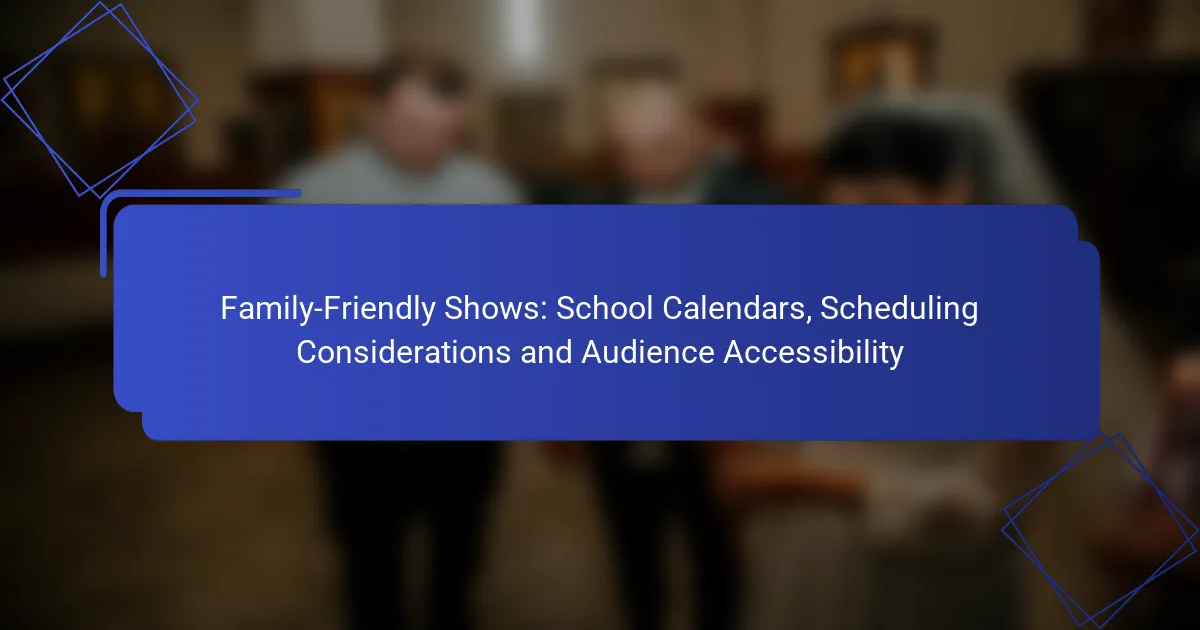Family-friendly shows for school-age children blend entertainment with educational value, making them perfect for young audiences. The scheduling of these programs is often aligned with school calendars, ensuring families can enjoy them together during breaks and holidays. Additionally, considering the timing of these shows is crucial for fitting them into daily routines, enhancing accessibility for both children and parents.

What are the best family-friendly shows for school-age children?
Family-friendly shows for school-age children typically combine entertainment with educational content, making them ideal for young viewers. Programs like “Bluey,” “Peppa Pig,” and “Sesame Street” not only engage children but also promote social skills, problem-solving, and creativity.
Bluey
“Bluey” is an Australian animated series that follows a lovable Blue Heeler puppy and her family. The show emphasizes imaginative play and family dynamics, often highlighting the importance of creativity and problem-solving in everyday situations.
Each episode runs for about seven minutes, making it easy to fit into busy schedules. Parents appreciate its relatable themes and positive messages about family life.
Peppa Pig
“Peppa Pig” is a British animated series that centers around Peppa, a cheeky little piggy, and her adventures with family and friends. The show is known for its simple animation style and humorous storytelling, which resonates well with young children.
Episodes are typically five minutes long, making them perfect for short viewing sessions. The series also introduces basic concepts like sharing and friendship, which are essential for social development.
Sesame Street
With episodes lasting around 30 minutes, it offers a comprehensive viewing experience. The show’s commitment to inclusivity and social issues makes it a valuable resource for parents and educators alike.
Daniel Tiger’s Neighborhood
“Daniel Tiger’s Neighborhood” is inspired by “Mister Rogers’ Neighborhood” and focuses on social-emotional learning. The show features Daniel, a young tiger, as he navigates everyday challenges with the help of his friends and family.
Each episode lasts about 28 minutes and includes catchy songs that reinforce important lessons about feelings, empathy, and cooperation. Parents often find it helpful for discussing emotions with their children.
Wild Kratts
“Wild Kratts” is an educational animated series that explores the animal kingdom through the adventures of the Kratt brothers. The show combines fun storytelling with scientific facts about wildlife and conservation.
Episodes are approximately 28 minutes long and encourage curiosity about nature. Parents appreciate its focus on environmental awareness and the importance of protecting wildlife, making it both entertaining and informative for young viewers.

How do school calendars affect family-friendly show scheduling?
School calendars significantly influence the scheduling of family-friendly shows by aligning with school breaks and holidays. This alignment ensures that families can watch together during periods when children are off from school, maximizing viewership and engagement.
Alignment with school breaks
Scheduling family-friendly shows during school breaks, such as summer vacation or winter holidays, allows for higher viewership as children are available to watch. Networks often release special episodes or series during these times to capitalize on the increased audience. For instance, a show might premiere its new season just before summer break to attract families looking for entertainment options.
Additionally, aligning show releases with local school calendars can enhance community engagement. For example, shows that incorporate themes related to back-to-school or holiday celebrations can resonate more with audiences during those specific times.
Impact on viewership
Viewership for family-friendly shows tends to spike during school breaks, as children are free from academic responsibilities. This increase can be substantial, sometimes reaching up to double the regular viewership numbers. Conversely, during school terms, viewership may drop significantly, as children have less time to watch television due to homework and extracurricular activities.
Producers and networks should consider these patterns when planning their schedules. Offering reruns or special events during school terms can help maintain audience interest, while promotional campaigns can remind families of new content during breaks. Understanding these dynamics is crucial for maximizing the reach and impact of family-friendly programming.

What scheduling considerations should families keep in mind?
Families should consider the timing of shows to ensure they fit into their daily routines. Key factors include prime time slots and weekend programming, which can significantly affect viewership and accessibility for children and parents alike.
Prime time slots
Prime time slots typically occur in the evening, usually between 7 PM and 10 PM, when families are more likely to be together at home. Scheduling shows during these hours can maximize viewership, but it may also conflict with homework or bedtime routines for younger children.
When planning viewing times, consider the age of the children and their typical schedules. For instance, shows aimed at younger audiences might perform better earlier in the evening, while older kids may stay up later. It’s essential to balance entertainment with necessary rest and responsibilities.
Weekend programming
Weekend programming provides a flexible option for families, as children often have more free time on Saturdays and Sundays. This can be an ideal time for family movie nights or special episodes that encourage group viewing.
However, families should be mindful of other weekend commitments, such as sports or family outings, which can impact viewership. Planning ahead by checking local listings and setting reminders can help ensure that families don’t miss out on their favorite shows.

How can families access these shows?
Families can access family-friendly shows through various platforms, including streaming services and broadcast television. Each option has its own advantages and considerations, making it essential to choose the best fit for your family’s needs.
Streaming platforms
Streaming platforms offer on-demand access to a wide range of family-friendly shows, allowing families to watch at their convenience. Popular services like Netflix, Disney+, and Amazon Prime Video provide extensive libraries tailored to children and families, often including original content.
When selecting a streaming service, consider subscription costs, device compatibility, and content variety. Some platforms may offer free trials, enabling families to explore their options without immediate financial commitment. Keep in mind that content availability may vary by region.
Broadcast television
Broadcast television remains a reliable way for families to access family-friendly programming, often featuring shows during designated time slots. Major networks like ABC, NBC, and PBS typically air children’s shows during the morning and early evening, catering to various age groups.
Families can benefit from local listings to find specific shows and their airtimes. Many broadcast channels also offer digital options, allowing viewers to catch up on missed episodes through their websites or apps. However, be aware that some shows may include advertisements, which can vary in frequency and content appropriateness.

What are the accessibility features of family-friendly shows?
Family-friendly shows often include accessibility features to ensure that all viewers, including those with disabilities, can enjoy the content. Key features include closed captioning and audio descriptions, which enhance understanding and engagement for diverse audiences.
Closed captioning availability
Closed captioning provides a text display of spoken dialogue and relevant sound effects, making shows accessible for viewers who are deaf or hard of hearing. Most family-friendly programming on major networks and streaming platforms offers this feature, often activated through settings on the device or app.
When selecting shows, check for the “CC” icon or look for options in the accessibility settings. Many platforms allow you to filter content based on closed captioning availability, ensuring you find suitable options for your family.
Audio descriptions
Audio descriptions offer a narrated account of visual elements in a show, such as actions, settings, and facial expressions, which is beneficial for viewers who are blind or have low vision. This feature is increasingly common in family-friendly programming, particularly on streaming services.
To access audio descriptions, look for settings labeled “Audio Descriptions” or “AD” when browsing shows. Some platforms allow you to enable this feature by default, ensuring a seamless viewing experience for all family members.

What are the benefits of watching family-friendly shows together?
Watching family-friendly shows together offers numerous benefits, including strengthening relationships and fostering open communication. These shared experiences can create lasting memories and provide a safe space for discussions about various topics.
Strengthening family bonds
Engaging in family-friendly shows allows family members to spend quality time together, which is essential for building strong relationships. Shared viewing experiences can lead to laughter, joy, and a sense of togetherness, making family members feel more connected.
To maximize bonding, choose shows that appeal to all ages and encourage participation. For instance, animated series or family comedies often resonate well with both children and adults, making it easier to enjoy the experience collectively.
Encouraging discussions
Family-friendly shows often present themes and situations that can spark meaningful conversations among family members. Discussing the plot, characters, and moral lessons can help children articulate their thoughts and feelings while allowing parents to share insights and guidance.
To facilitate discussions, consider asking open-ended questions after watching an episode. Questions like “What did you think about the character’s choice?” or “How would you handle that situation?” can encourage children to express their opinions and develop critical thinking skills.



